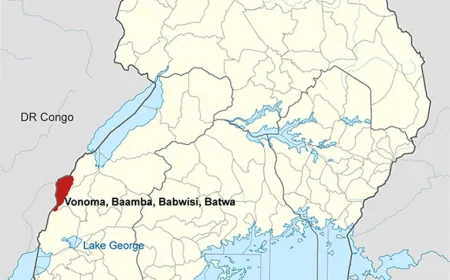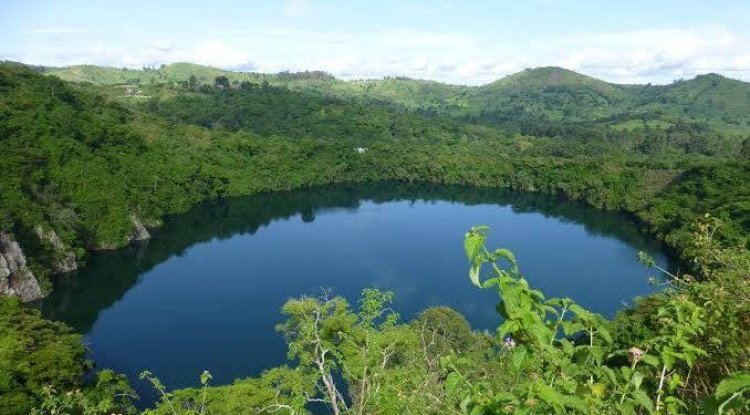Mabira Central Forest Reserve
Mabira is not only a biodiversity hotspot, but also a cultural and historical treasure. The forest is sacred to the Baganda people, the dominant ethnic group in Uganda.
A Forest of Wonders
Imagine walking through a lush green forest, listening to the sounds of birds, monkeys, and waterfalls. Imagine breathing in the fresh air, feeling the cool breeze, and spotting colorful butterflies and flowers. Imagine discovering ancient trees, rare plants, and endangered animals. This is not a fantasy but a reality in Mabira Central Forest Reserve, one of Uganda's largest and most diverse natural forests.
Location and Geography: A Vital Water Catchment Area
Mabira Central Forest Reserve covers an area of 306 square kilometers in the districts of Buikwe, Mukono, and Kayunga. It lies on the main Kampala-Jinja highway, about 54 kilometers from Kampala and 26 kilometers from Jinja. The forest is a vital water catchment area for several rivers and lakes, including the Nile, Ssezibwa, Victoria, and Kyoga. It also plays a crucial role in regulating the climate, preventing soil erosion, and providing ecosystem services.
Biodiversity: A Home to Over 1,000 Species
Mabira is home to over 300 species of trees, some of which are endemic, endangered, or medicinal. Some of the notable tree species include the mvule, the red stinkwood, the African mahogany, and the strangler fig. The forest also hosts over 300 species of birds, including the Nahan's francolin, the papyrus gonolek, the great blue turaco, and the grey parrot. Mabira is one of the few places in the world where you can find the forest ground thrush, a critically endangered bird that is only found in Central Africa.
The forest is also rich in wildlife, with over 20 species of small mammals, such as the blue duiker, the bush pig, the tree hyrax, the red-tailed monkey, the grey-cheeked mangabey, and the bush baby. There are also reports of leopards, although they are very rare and elusive. Mabira is also a haven for butterflies, moths, reptiles, amphibians, and insects, with over 200 species of each.
Culture and History: A Sacred and Protected Forest
Mabira is not only a biodiversity hotspot but also a cultural and historical treasure. The forest is sacred to the Baganda people, the dominant ethnic group in Uganda. They believe that the forest is the dwelling place of Musisi, the god of food and rain. The forest also provides herbs and medicines for the local communities, as well as food, firewood, and crafts. Mabira has a long history of human use and conservation, dating back to the pre-colonial era. The forest was declared a protected area in 1932 by the British colonial government and has since been managed by various institutions, such as the Forest Department, the National Forestry Authority, and the Uganda Wildlife Authority.
Ecotourism and Recreation: A Range of Activities and Attractions
Mabira is also a popular destination for ecotourism and recreation. The forest offers a range of activities and attractions for visitors, such as forest walks, mountain biking, bird watching, primate watching, butterfly identification, camping, and picnics. There are over 68 kilometers of well-developed trails in the forest, leading to various points of interest, such as the Griffin Falls, the Ssezibwa River, the Nile Viewpoint, and the Eco-Tourism Centre. The Eco-Tourism Centre, located near Najjembe Trading Centre, is a community-based initiative that provides accommodation, catering, and guiding services for tourists. The centre has three bandas, which can accommodate up to 10 guests, and a camping ground for caravans. The centre also organizes cultural performances, handicrafts, and environmental education programs for visitors.
Another option for accommodation is the Mabira Forest Lodge, a modern eco-friendly facility owned by the Alam Group of Companies. The lodge is situated in the heart of the forest and offers luxury cottages, a swimming pool, a spa, a restaurant, and a conference hall. The lodge is ideal for those who want to enjoy the tranquility and beauty of the forest while having access to modern amenities and services.
Conclusion: A Forest that Deserves to be Explored, Appreciated, and Conserved
Mabira Central Forest Reserve is a hidden gem of Uganda, a country that is known for its natural wonders and wildlife. Mabira is a forest that has something for everyone, whether you are a nature lover, a bird watcher, a hiker, a cyclist, or a culture enthusiast. Mabira is a forest that deserves to be explored, appreciated, and conserved for the benefit of present and future generations.
What's Your Reaction?
 Like
0
Like
0
 Dislike
0
Dislike
0
 Love
0
Love
0
 Funny
0
Funny
0
 Angry
0
Angry
0
 Sad
0
Sad
0
 Wow
0
Wow
0
















































































